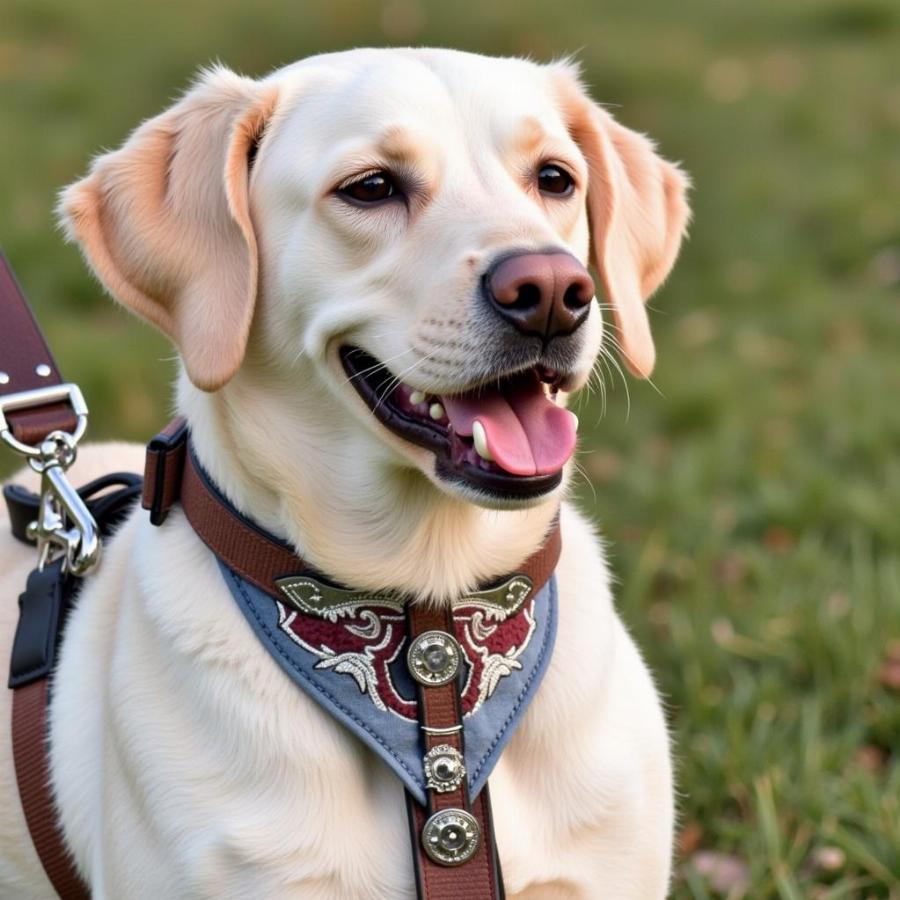Western collars for dogs, often adorned with intricate tooling and sturdy hardware, offer a blend of style and functionality. But beyond their aesthetic appeal, these collars serve a crucial purpose in the life of a working dog, or even a pampered pup wanting a touch of the Wild West. Choosing the right western collar involves understanding your dog’s needs, the collar’s purpose, and the materials used in its construction.
Understanding Western Dog Collars
Western dog collars are more than just fashion statements. They are a reflection of a rich history, rooted in the practicality of working ranches and the rugged terrain of the American West. Traditionally crafted from durable leather, these collars feature heavy-duty buckles and rings designed to withstand the rigors of daily life for a working dog. Whether your dog is herding cattle or simply strolling through the park, a western collar can add a touch of rustic charm to their appearance. What makes a western collar unique? Think ornate tooling, conchos (decorative metal ornaments), and often a wider band than standard collars.
Choosing the Right Material: Leather, Nylon, or BioThane?
The material of your western dog collar plays a vital role in its durability, comfort, and overall suitability for your dog. Leather, a classic choice, offers durability and a timeless aesthetic. However, it requires regular conditioning to maintain its suppleness and can be susceptible to damage from water. Nylon western collars are a more budget-friendly option, known for their easy maintenance and water resistance. BioThane, a synthetic material, combines the best of both worlds: the look and feel of leather with the durability and water resistance of nylon. Consider your dog’s lifestyle and activity level when selecting the material. A leather western dog collars might be perfect for occasional wear, while a BioThane option is ideal for active dogs who love the outdoors.
Sizing Your Dog for a Western Collar
A properly fitted collar is crucial for your dog’s comfort and safety. Too tight, and it can restrict breathing or cause skin irritation. Too loose, and your dog might slip out. To measure your dog for a western collar, use a flexible measuring tape and measure around their neck, leaving enough space for two fingers to fit comfortably between the collar and their skin. This ensures a snug but not restrictive fit. Don’t rely on your dog’s old collar for sizing, as it might have stretched or shrunk over time.
Western Collars for Working Dogs: Function Over Fashion
For working dogs, a western collar is more than just an accessory; it’s a vital piece of equipment. The sturdy construction and heavy-duty hardware are designed to withstand the demands of their job. Look for collars with reinforced stitching, rust-resistant buckles, and D-rings strong enough to hold leashes and other training tools. Consider wrangler dog collar options, known for their durability and reliability. For dogs susceptible to tick-borne diseases, understanding anaplasmosis in dogs treatment is vital, and a sturdy collar can help with tick prevention methods.
Styling Your Dog with a Western Collar: Accessorizing and Considerations
Western collars can be styled in various ways to complement your dog’s personality and coat. Conchos, buckles, and tooling can add unique flair. Just remember, while style is important, comfort and functionality should always come first. Avoid overly embellished collars that might be heavy or irritate your dog’s skin. Consider personalized waterproof dog collars for a personal touch. For dogs that tend to slip their collars, explore slip on collars for dogs options which offer added security.
 Accessorizing Your Dog's Western Collar
Accessorizing Your Dog's Western Collar
Conclusion
Choosing the right western collar for your dog requires careful consideration of their needs, lifestyle, and the collar’s purpose. By understanding the materials, sizing, and styling options available, you can ensure your dog looks great and stays safe and comfortable. Western collars, with their blend of style and function, are a timeless choice for any dog owner looking to add a touch of the Wild West to their canine companion’s wardrobe.
FAQ
-
Are western collars suitable for all dog breeds? Yes, western collars can be suitable for most breeds, but choosing the right size and material is essential.
-
How do I clean a leather western collar? Use a damp cloth and leather cleaner specifically designed for dog collars.
-
Can I use a western collar for training? Yes, the sturdy D-ring makes them suitable for attaching leashes and training tools.
-
What are conchos? Conchos are decorative metal ornaments often found on western collars.
-
Are nylon western collars as durable as leather? While durable, nylon collars might not last as long as well-maintained leather collars.
-
How do I measure my dog for a collar? Measure around their neck, allowing two fingers to fit comfortably between the tape and their skin.
-
Where can I buy authentic western dog collars? Reputable pet stores and online retailers specializing in dog accessories are good places to start.
Beaut Dogs is your trusted source for all things canine, offering expert advice and guidance on dog breeds, care, and products. For personalized assistance with choosing the perfect western collar or any other dog-related query, contact us at Email: [email protected]. We’re here to help you navigate the wonderful world of dog ownership.